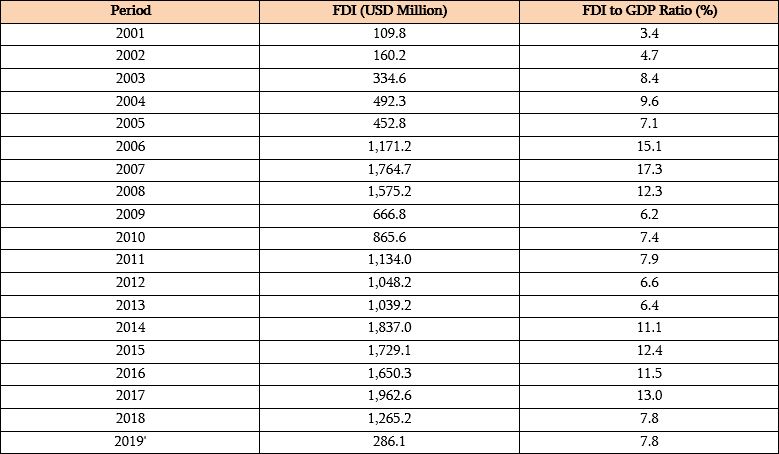Resume: The Deputy Minister of Economy made this statement in regard to the volume of foreign direct investments made in the first quarter of 2019 when investments amounted to USD 286.1 million which is the lowest figure in that period since 2011.
Since the third quarter of 2012 up until the present day, approximately USD 10 billion in foreign direct investment was made in Georgia whilst the amount of FDI in 2001-2012 was USD 9.5 billion. However, adding the absolute figures of FDI in this manner is speculative and cannot be considered as an indicator for a success dynamic because economic circumstances in different years differ from each other and, therefore, it is more relevant to analyse relative figures. In 2012-2018, the FDI to GDP ratio was on average nearly 10% whilst it was 8% in 2001-2012. However, the average figures for 2001-2012 are negatively affected by the very poor performance of 2001-2002 when FDI was almost non-existent.
Since the Georgian Dream’s coming to power, the period of 2014-2017 was quite successful in terms of the attraction of investments (12% on average) which only lags behind the figures for 2006-2008 (14.9% on average). However, this positive dynamic substantially worsened in 2018 and the trend of decrease was evident in 2019 as well. Therefore, the Deputy Minister’s attempt to put an emphasis on average figures aims to conceal the existing problems and misleads the public.
Given the fact that the given figures are correct, on the one hand, but calculated using the wrong approach, on the other, the formulation of the analysis in this manner serves to conceal other more important information. FactCheck leaves this statement WITHOUT A VERDICT and limits this article to analysis alone.
Analysis
As stated by the Deputy Minister of the Economy and Sustainable Development, Ekaterine Mikabadze: “There were more foreign direct investments in Georgia in the last years as compared to the 12 years before.”
Foreign direct investment (FDI) implies a resident of one country owning a share in a foreign-based enterprise and carrying out different types of economic operations related to that enterprise. An investor is considered to be a direct one if he has at least a 10% ownership stake in a foreign-based enterprise’s shares or the equivalent of such participation.
Ekaterine Mikabadze made her statement in regard to the volume of foreign direct investments in the first quarter of 2019 when investments amounted to USD 286.1 million which is the lowest figure since 2011. Of note is that a sharp decrease in FDI was registered in 2018 as compared to the previous years. The completion of BP’s gas pipeline project, which was being built in the previous years and used to have a positive impact upon the previous FDI volume, was named as a major component stipulating a decrease in FDI. At the same time, several enterprises changed ownership and are now owned by Georgian residents and, therefore, investments in such enterprises are no longer considered as foreign investment.
Graph 1:Foreign Direct Investments in 2001-2018

Source: National Statistics Office of Georgia
Since the third quarter of 2012 up until the present day, approximately USD 10 billion in foreign direct investment has been made in Georgia whilst the amount of FDI in 2001-2012 was USD 9.5 billion. However, adding the absolute figures of FDI in this manner is speculative and cannot be considered as an indicator for a success dynamic because economic circumstances in different years differ from each other and, therefore, it is more relevant to analyse relative figures. In 2012-2018, the FDI to GDP ratio was nearly 10% on average whilst it was 8.8% in 2001-2012. However, the average figures for 2001-2012 are negatively affected by a very poor performance in 2001-2002 when FDI was almost non-existent.
Since the Georgian Dream’s coming to power, the period of 2014-2017 was quite successful in terms of the attraction of investments (12% on average) which only lags behind the figures for 2006-2008 (14.9% on average). However, this positive dynamic substantially worsened in 2018 and a trend of decrease was evident in 2019 as well. Therefore, the Deputy Minister’s attempt to put emphasis on average figures aims to conceal the existing problems and misleads the public.








